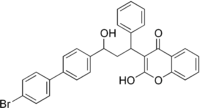Bromadiolone
 | |
| Names | |
|---|---|
| IUPAC name
3-[3-[4-(4-Bromophenyl)phenyl]-3-hydroxy-1-phenylpropyl]-2-hydroxychromen-4-one | |
| Other names
Broprodifacoum; Bromatrol | |
| Identifiers | |
| 28772-56-7 | |
| ChEMBL | ChEMBL1165553 |
| ChemSpider | 10606098 |
| |
| Jmol-3D images | Image |
| KEGG | C18596 |
| PubChem | 34322 |
| |
| Properties | |
| Molecular formula |
C30H23BrO4 |
| Molar mass | 527.41 g·mol−1 |
| Hazards | |
| Main hazards | |
| Except where noted otherwise, data is given for materials in their standard state (at 25 °C (77 °F), 100 kPa) | |
| Infobox references | |
Bromadiolone is a potent anticoagulant rodenticide. It is a second-generation 4-hydroxycoumarin derivative and vitamin K antagonist, often called a "super-warfarin" for its added potency and tendency to accumulate in the liver of the poisoned organism. When first introduced to the UK market in 1980, it was effective against the populations that had become resistant to the first generation anticoagulants.
The product may be used both indoors and outdoors for rats and mice.
Toxicity
Bromadiolone can be absorbed through the digestive tract, through the lungs, or through skin contact. The pesticide is generally given orally.[1] The substance is a vitamin K antagonist. The lack of vitamin K in the circulatory system reduces blood clotting and will cause death due to internal hemorrhaging.[1]
Poisoning doesn't show up for 24 to 36 hours after poison is eaten and often it may take 2–5 days for the signs to show up.
Following are acute LD50 values for various animals (mammals):[1]
- rats 1.125 mg/kg b.w.
- mice 1.75 mg/kg b.w.
- rabbits 1 mg/kg b.w.
- dogs > 10 mg/kg b.w. (oral MTD)[2]
- cats > 25 mg/kg b.w. (oral MTD)[2]
Chemistry
The compound is used as a mixture of four stereoisomers. Its two stereoisomeric centers are at the phenyl- and the hydroxyl-substituted carbons in the carbon chain of the substituent at the 3 position of the coumarin.
Antidote
Vitamin K1 is used as antidote.[3]
References
- ↑ 1.0 1.1 1.2 Bromadiolone
- ↑ 2.0 2.1 The Veterinarian’s Guide to accidental rodenticide ingestion by dogs & cats
- ↑ Bromadiolone (Bromone, Maki) Chemical Profile 1/85, Pesticide Management Education Program, Cornell University
| ||||||||||||||||||||||||||||||||||||||||||||||||||